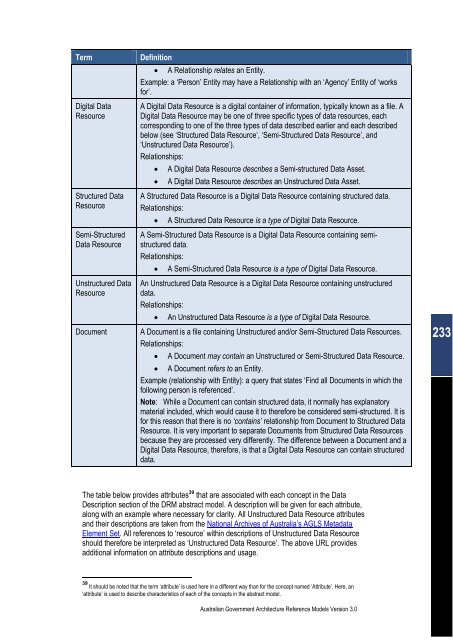Australian Government Architecture Reference Models Version 3.0
Australian Government Architecture Reference Models Version 3.0
Australian Government Architecture Reference Models Version 3.0
Create successful ePaper yourself
Turn your PDF publications into a flip-book with our unique Google optimized e-Paper software.
Term Definition<br />
Digital Data<br />
Resource<br />
Structured Data<br />
Resource<br />
Semi-Structured<br />
Data Resource<br />
Unstructured Data<br />
Resource<br />
Document<br />
� A Relationship relates an Entity.<br />
Example: a ‘Person’ Entity may have a Relationship with an ‘Agency’ Entity of ‘works<br />
for’.<br />
A Digital Data Resource is a digital container of information, typically known as a file. A<br />
Digital Data Resource may be one of three specific types of data resources, each<br />
corresponding to one of the three types of data described earlier and each described<br />
below (see ‘Structured Data Resource’, ‘Semi-Structured Data Resource’, and<br />
‘Unstructured Data Resource’).<br />
Relationships:<br />
� A Digital Data Resource describes a Semi-structured Data Asset.<br />
� A Digital Data Resource describes an Unstructured Data Asset.<br />
A Structured Data Resource is a Digital Data Resource containing structured data.<br />
Relationships:<br />
� A Structured Data Resource is a type of Digital Data Resource.<br />
A Semi-Structured Data Resource is a Digital Data Resource containing semistructured<br />
data.<br />
Relationships:<br />
� A Semi-Structured Data Resource is a type of Digital Data Resource.<br />
An Unstructured Data Resource is a Digital Data Resource containing unstructured<br />
data.<br />
Relationships:<br />
� An Unstructured Data Resource is a type of Digital Data Resource.<br />
A Document is a file containing Unstructured and/or Semi-Structured Data Resources.<br />
Relationships:<br />
� A Document may contain an Unstructured or Semi-Structured Data Resource.<br />
� A Document refers to an Entity.<br />
Example (relationship with Entity): a query that states ‘Find all Documents in which the<br />
following person is referenced’.<br />
Note: While a Document can contain structured data, it normally has explanatory<br />
material included, which would cause it to therefore be considered semi-structured. It is<br />
for this reason that there is no ‘contains’ relationship from Document to Structured Data<br />
Resource. It is very important to separate Documents from Structured Data Resources<br />
because they are processed very differently. The difference between a Document and a<br />
Digital Data Resource, therefore, is that a Digital Data Resource can contain structured<br />
data.<br />
The table below provides attributes 39 that are associated with each concept in the Data<br />
Description section of the DRM abstract model. A description will be given for each attribute,<br />
along with an example where necessary for clarity. All Unstructured Data Resource attributes<br />
and their descriptions are taken from the National Archives of Australia’s AGLS Metadata<br />
Element Set. All references to ‘resource’ within descriptions of Unstructured Data Resource<br />
should therefore be interpreted as ‘Unstructured Data Resource’. The above URL provides<br />
additional information on attribute descriptions and usage.<br />
39 It should be noted that the term ‘attribute’ is used here in a different way than for the concept named ‘Attribute’. Here, an<br />
‘attribute’ is used to describe characteristics of each of the concepts in the abstract model.<br />
<strong>Australian</strong> <strong>Government</strong> <strong>Architecture</strong> <strong>Reference</strong> <strong>Models</strong> <strong>Version</strong> <strong>3.0</strong><br />
233

















